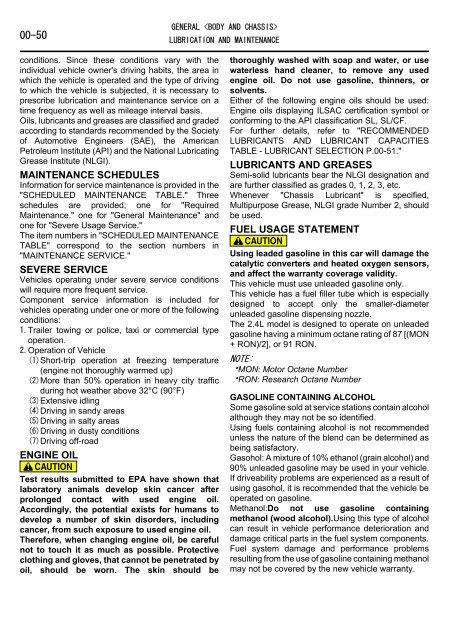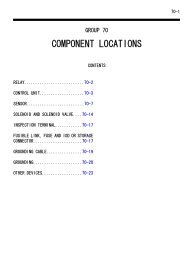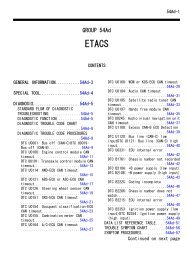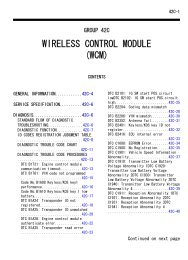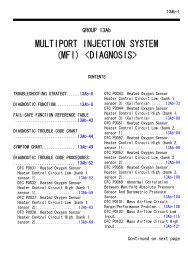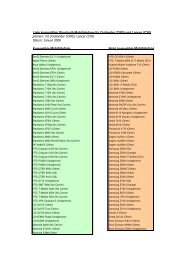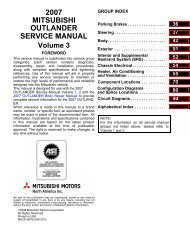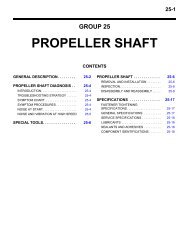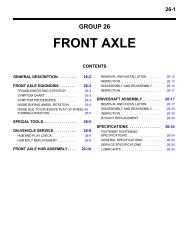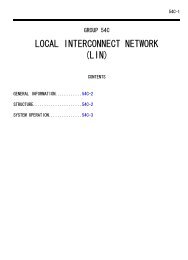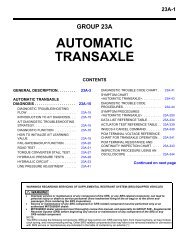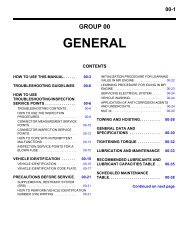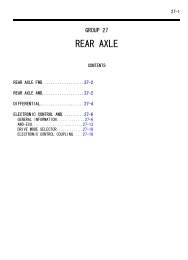P.00-15 - Outlander-Forum
P.00-15 - Outlander-Forum
P.00-15 - Outlander-Forum
You also want an ePaper? Increase the reach of your titles
YUMPU automatically turns print PDFs into web optimized ePapers that Google loves.
00-50<br />
GENERAL <br />
LUBRICATION AND MAINTENANCE<br />
conditions. Since these conditions vary with the<br />
individual vehicle owner's driving habits, the area in<br />
which the vehicle is operated and the type of driving<br />
to which the vehicle is subjected, it is necessary to<br />
prescribe lubrication and maintenance service on a<br />
time frequency as well as mileage interval basis.<br />
Oils, lubricants and greases are classified and graded<br />
according to standards recommended by the Society<br />
of Automotive Engineers (SAE), the American<br />
Petroleum Institute (API) and the National Lubricating<br />
Grease Institute (NLGI).<br />
MAINTENANCE SCHEDULES<br />
Information for service maintenance is provided in the<br />
"SCHEDULED MAINTENANCE TABLE." Three<br />
schedules are provided; one for "Required<br />
Maintenance." one for "General Maintenance" and<br />
one for "Severe Usage Service."<br />
The item numbers in "SCHEDULED MAINTENANCE<br />
TABLE" correspond to the section numbers in<br />
"MAINTENANCE SERVICE."<br />
SEVERE SERVICE<br />
Vehicles operating under severe service conditions<br />
will require more frequent service.<br />
Component service information is included for<br />
vehicles operating under one or more of the following<br />
conditions:<br />
1.Trailer towing or police, taxi or commercial type<br />
operation.<br />
2.Operation of Vehicle<br />
(1)Short-trip operation at freezing temperature<br />
(engine not thoroughly warmed up)<br />
(2)More than 50% operation in heavy city traffic<br />
during hot weather above 32°C (90°F)<br />
(3)Extensive idling<br />
(4)Driving in sandy areas<br />
(5)Driving in salty areas<br />
(6)Driving in dusty conditions<br />
(7)Driving off-road<br />
ENGINE OIL<br />
Test results submitted to EPA have shown that<br />
laboratory animals develop skin cancer after<br />
prolonged contact with used engine oil.<br />
Accordingly, the potential exists for humans to<br />
develop a number of skin disorders, including<br />
cancer, from such exposure to used engine oil.<br />
Therefore, when changing engine oil, be careful<br />
not to touch it as much as possible. Protective<br />
clothing and gloves, that cannot be penetrated by<br />
oil, should be worn. The skin should be<br />
thoroughly washed with soap and water, or use<br />
waterless hand cleaner, to remove any used<br />
engine oil. Do not use gasoline, thinners, or<br />
solvents.<br />
Either of the following engine oils should be used:<br />
Engine oils displaying ILSAC certification symbol or<br />
conforming to the API classification SL, SL/CF.<br />
For further details, refer to "RECOMMENDED<br />
LUBRICANTS AND LUBRICANT CAPACITIES<br />
TABLE - LUBRICANT SELECTION <strong>P.00</strong>-51."<br />
LUBRICANTS AND GREASES<br />
Semi-solid lubricants bear the NLGI designation and<br />
are further classified as grades 0, 1, 2, 3, etc.<br />
Whenever "Chassis Lubricant" is specified,<br />
Multipurpose Grease, NLGI grade Number 2, should<br />
be used.<br />
FUEL USAGE STATEMENT<br />
Using leaded gasoline in this car will damage the<br />
catalytic converters and heated oxygen sensors,<br />
and affect the warranty coverage validity.<br />
This vehicle must use unleaded gasoline only.<br />
This vehicle has a fuel filler tube which is especially<br />
designed to accept only the smaller-diameter<br />
unleaded gasoline dispensing nozzle.<br />
The 2.4L model is designed to operate on unleaded<br />
gasoline having a minimum octane rating of 87 [(MON<br />
+ RON)/2], or 91 RON.<br />
NOTE:<br />
⦆MON: Motor Octane Number<br />
⦆RON: Research Octane Number<br />
GASOLINE CONTAINING ALCOHOL<br />
Some gasoline sold at service stations contain alcohol<br />
although they may not be so identified.<br />
Using fuels containing alcohol is not recommended<br />
unless the nature of the blend can be determined as<br />
being satisfactory.<br />
Gasohol: A mixture of 10% ethanol (grain alcohol) and<br />
90% unleaded gasoline may be used in your vehicle.<br />
If driveability problems are experienced as a result of<br />
using gasohol, it is recommended that the vehicle be<br />
operated on gasoline.<br />
Methanol:Do not use gasoline containing<br />
methanol (wood alcohol).Using this type of alcohol<br />
can result in vehicle performance deterioration and<br />
damage critical parts in the fuel system components.<br />
Fuel system damage and performance problems<br />
resulting from the use of gasoline containing methanol<br />
may not be covered by the new vehicle warranty.


